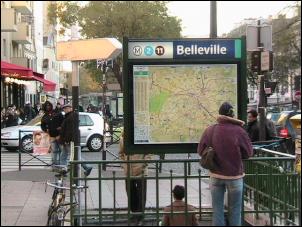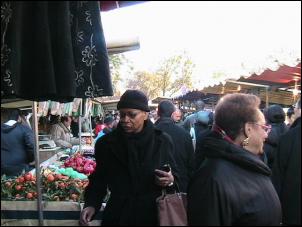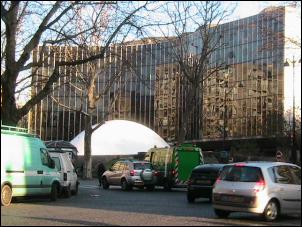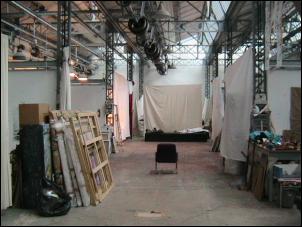Les Yeux on France: Urban Triumph in Belleville
Les Yeux on France: Urban Triumph in Belleville

Index:
Introduction
Video
Audio
Text
*******
If ever a place deserves the ‘melting-pot’ label, it is Belleville. A lively neighbourhood in the east of the French capital, Belleville covers the surface of the second-highest hill in Paris. Le Bas Belleville is at the bottom of the hill, centred around Boulevard de la Villette and Belleville metro station. It is one of the last strongholds of the ‘popular’ classes (that is, working class, especially immigrant communities) in inner-city Paris. Here, the streets are lined with kosher butchers and internet cafes close midday for prayer time (on Fridays at least). The Tuesday and Friday morning markets – amongst the cheapest in Paris – are punctured by friendly cries of ‘Yala!’
![]() Scoop Audio: Click here to listen to this
edition of Les Yeux on
France
Scoop Audio: Click here to listen to this
edition of Les Yeux on
France

(PARIS) – A suspended work by the artist Ben gives life to Place Fréhel. Elaborate graffiti murals likewise sharpen the character of Belleville’s streets. In rue Denoyez, three young men add to the existing artwork with their spray-paint. They say they come from the suburbs on the outskirts of Paris, and that they are studying art in one of the nearby workshops. An elderly baker comes out from a neighbouring shop in his apron, not to scold the youths, but to advise them that they need to use more colour in their work.
Further up the hill, Chinese restaurants and Egyptian convenience stores that line rue de la Belleville give way to more traditional French bakeries, patisseries and cafes.

Residents of Belleville tend to have a strong sense of local identity. For many locals, the combination of lively cosmopolitanism and staunchly working class history is a source of pride.
The people of Belleville fought hard in support of the revolutionary Paris Commune of 1871. Belleville was the last pocket of resistance in the vicious street fight against the Versailles Army. This fiercely leftwing spirit has long been maintained. Indeed, the Communist Party headquarters are sited on the edge of Belleville, at Place Colonel Fabien.
This identity has continually evolved as various immigrant communities have become incorporated in the neighbourhood’s social fabric in a harmonious and organic way. From the 1920s and 1930s, Jewish, Polish, Greek and Armenian immigrants flocked to Belleville. They were soon followed after by Spaniards and Portuguese. Later came Tunisian Jews and Muslims from Algeria, Morocco and Tunisia. More recently, something of a Chinatown has been established in the area, assisted by relatively cheap real-estate.

Equally significant was the arrival of intellectuals, artists and actors. They began coming here in the 1980s. For one, Belleville was cheaper. More than that, however, the area was one of few in Paris passed by during the modernisation that changed the face of the rest of the city during the 1960s and 1970s. Thus there were many large abandoned spaces ready and waiting to be turned into studios and art squats.
When authorities finally moved to catch Belleville up with the rest of Paris in the 1980s, they faced much opposition. Locals were intensely resistant to the type of reconstruction that has forced so much of the Parisian working class out of most other formerly ‘popular’ areas (Marais, Bastille, Montrematre…). Associations such as La Bellevilleuse began the fight to conserve the distinctive nature of Belleville’s urban environment: ‘For the Paris WE want’.
Eventually the authorities came on board, notably with substantial financing for property owners. Substandard buildings were mostly rehabilitated, rather than completely reconstructed. In contrast to many other Parisian districts, many underprivileged, long-time inhabitants were able to stay on.
La Forge de Belleville is an interesting example of activism by artists that has triumphed and helped enrich Belleville. The association began as a group of artists who occupied an abandoned ironworks building on 21 October 1991. They squatted there to save the building from demolition. Instead, they transformed it into a dedicated working space for artists.

‘La Forge de Belleville is an association which unites 25 artists who struggle… against and with the Paris City Council, to preserve studios for artists in Paris. It’s becoming more and more difficult’ explains Irène Quesnay. The painter is one of those with a permanent studio at La Forge. ‘The association’s mission is to coordinate the studios, as well as to organise events for the public around Belleville.’
In recent years, a special annual event has emerged in this neighbourhood to highlight artists such as Quesnay. Mid-May, for 4 days, visitors are welcomed into around 150 studios throughout Belleville. Next year will be the 15th anniversary of this event, ‘Journées Portes ouvertes des ateliers, d’artistes de Belleville’ (Open day for Belleville’s studios and artists). The event is drawing crowds every year, as people come to celebrate the uniqueness of Belleville. Let’s hope it stays that way.
Yasmine Ryan is a graduate of the University of Auckland, in Political Studies and French language. She is currently completing a Masters degree in International Journalism at the Institut d’Etudes Politiques, Aix-en-Provence.
ENDS


 Gordon Campbell: On The Government’s Latest Ferries Scam
Gordon Campbell: On The Government’s Latest Ferries Scam Peter Dunne: Dunne's Weekly - While We're Breaking Up Monoliths, What About MBIE?
Peter Dunne: Dunne's Weekly - While We're Breaking Up Monoliths, What About MBIE? Adrian Maidment: Supermarket Signs
Adrian Maidment: Supermarket Signs Ian Powell: Revisiting Universalism
Ian Powell: Revisiting Universalism Martin LeFevre - Meditations: In A Global Society, There Is No Such Thing As “National Security”
Martin LeFevre - Meditations: In A Global Society, There Is No Such Thing As “National Security” Binoy Kampmark: Secrecy And Virtue Signalling - Another View Of Signalgate
Binoy Kampmark: Secrecy And Virtue Signalling - Another View Of Signalgate